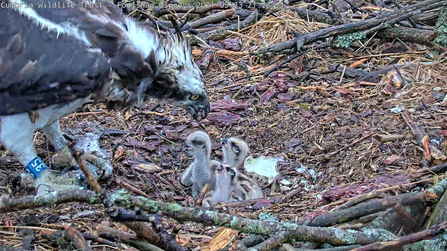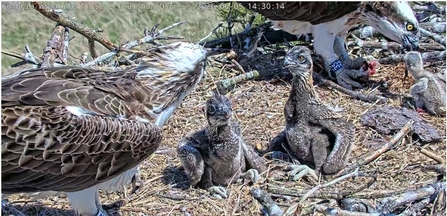The lives of the osprey chicks... a closer look
May was a busy month for the ospreys at Foulshaw Moss, Cumbria Wildlife Trust's nature reserve near Grange over Sands. On Tuesday 18 May the first of three eggs hatched out, followed by a second on Thursday 20 May and the final one on Saturday 22 May 2021.
We call the newly hatched chicks bobbleheads, because they sit there with their little heads bobbling about as they take in the world.
A more scientific term for young ospreys is ‘semiprecocial’, which means that they are not born helpless, blind and naked like a blackbird, but nor do they pop out raring to go like curlews, who within hours are running about by themselves. Osprey chicks sit somewhere in the middle, quite literally, as they can sit up within a few hours.
They are born with a coat of white, fluffy down, except around the eyes, where they have the distinctive black ‘bandit’ mask of their parents. This mask reduces glare from water when the birds are fishing. The tiny chicks are on the lookout for fish too, but only from their parents' beaks.

That’s another thing little ospreys can do within hours of hatching – eat. They are fed on raw fish within 4 hours of appearing. There are no rusks on offer around here. This high protein diet is the secret to successful body building.
The chicks hatch weighing about 50 grams. In the first 8 days they triple their weight, then in the next four days double it again. That means that in under a fortnight they have increased in size six times. And they don’t stop there.
From 15 – 30 days old they have another growth spurt, putting on about 40 grams a day, nearly their birth weight. They add 2-3% of their final body weight every 24 hours. That’s like a human child putting on over 2 kilos every day. In short, they like their grub.

They grow fast, but still need looking after. The parents are very careful, walking around the nest on their knuckles to keep those ferocious talons out of the way.
Then there’s the unpredictable Cumbrian weather. When the rain comes down, they are covered over with the ‘mumbrella’ as the female bird shelters them beneath her body or wings. If the sun breaks out, she perches on the side of the nest with her wings out to create shade, following the sun around the sky to keep them cool.

It’s not easy keeping them safe and fed, but this is the eighth brood our pair have raised, so we are keeping our fingers crossed for another successful season.
Follow their story live on our osprey webcam

